“upon Forked Sticks….”
Alternatives to Stacking Arms.
By Richard F. C. Seidemann Jr.
55th Regt. Compy. Of Light Infantry (1759-1764)
www.55thregimentcompyoflightinfantry1759-1764.yolasite.com
Going to the Grand Encampment I, at Boone’s Homestead in
Fig. I
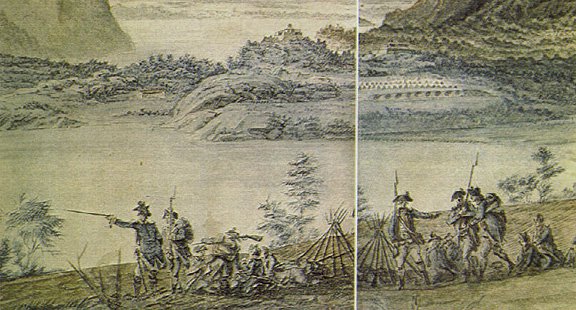
Source: http://www.najecki.com/repro/Special-Images.html
For those units that may be interested, I’d like to offer some alternatives to stacking arms, using entries from period sources.
Bell of Arms or Bell Tent:
The most obvious alternative is the use of a Bell of Arms or Bell Tent.
“There is a third sort of tent, called bell tent, from it resemblance, which serves to shelter the fire arms of the infantry from rain… This tent is fixed by means of a standard only and a few pegs… is marked the number and device of the regiment.”[2]
“The Arms to be Cleand and Rang’d in the Bell Tents with the Barrells outward.”[3]
“there is a sergeant’s tent at the end of every ten, and in the front of his door is the bell-tent, (two to each company) in which are kept all the men's firelocks.”[4]
Fig. II
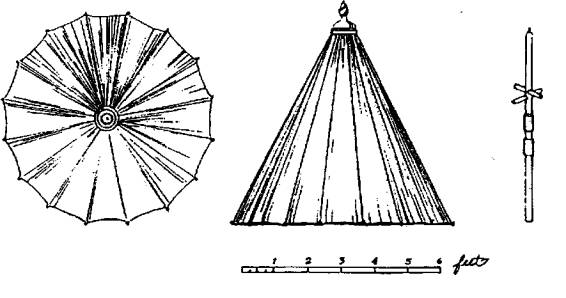
Diagram of the Bell Tent.
Source: http://www.revwar75.com/library/rees/shelter1.htm
Fig. III
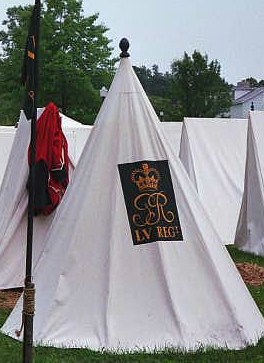
Reproduction Bell Tent with regimental number and device.
Source: Author's photo.
Fig. IV

Bell Tents are clearly visible in this painting from 1780.
Source: http://www.najecki.com/repro/special/Montague1.jpg
Fig. V

Encampment at Flanders, ca 1747 attributed to Thomas Sandby.
Source: FandI_WarProgressiveCampainer Yahoogroup
http://groups.yahoo.com/group/FandI_WarProgressiveCampaigner/files/British%20Camp%20images/
Forked Sticks:
Another option that groups may choose is the “Forked Stick.”
“The Hatchet Men are to… plant forks for the Arms with a Roof of Bark to cover them.”[5]
“The Piqt within ye Lines are for ye Future to Ground their Arms upon Forked Sticks, & a Sentry to Be Plaised Over them. Where they are to Remain with ye Offrs Fuzie in ye Front, Except it Be in Rainy Weather That they May Upon ye Least alarm Be Ready to March emediately.”[6]
Fig. VI

This German print shows muskets grounded upon forked sticks. One the left another method of grounding firelocks can be seen.
Source: Was ist jedem Officier waehrend eines Feldzugs zu wissen noethig (trans., “What it is necessary for each officer to know during a campaign”)
Fig. VII
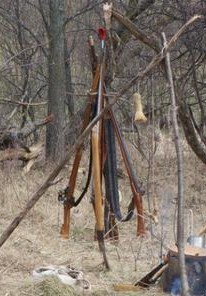
A “forked stick” made like those in a Bell Tent being used by re-enactors
of the 55th Regt, Compy of Light Infantry interpreting an Out-guard post.
Source: author’s photo.
Horses:
“the officers will… see that Horses are fixed in a proper manner before the Serjt’s Tents, to fix the arms of the Companies on.”[7]
“Horses to be immediately fixed up in the Front of the serg’ts tents to lodge the companies arms on in the day time. This last its expected will never be ordered again but that care will be taken at all times when we move to have them on the Next ground Whatever.”[8]
This last entry, tends to lead to the theory that the horses were being made at each new encampment from available resources. A horse could then easily be constructed out of branches at an event or branches that can be taken to an event.
Fig. VIII

In the very bottom left corner a “horse” can be seen in this painting
from the American War of Independence.
Source: http://www.najecki.com/repro/special/Stewart-2.jpg
Fig. IV.
An arms “horse” built by the 55th Regt, Compy. of Light Infantry at an Out-guard post.
Source: Author’s photo.
Grounding Arms:
A simple method that requires absolutely no material, is quite simply grounding your firelocks.
“It’s the Generals orders that the additional [picquets] be made up to 100 men, and that they ground their arms in front of the encampment and be ready to turn out at a moments warning….”[9]
“the soldiers who guard the intrenchment or fort, are to sit all night on the banguette, leaning their muskets on or against the parapet, and to take care to be alert all the time.”[10]
“the commander must make his men lay their arms on the top of the parapet, and see that they cover the locks with their haver-sacks, in order to preserve both them and the priming from dust, dirt, or moisture.”[11]
“if an officer has relieved a party in the open field, in a post without any fortifications, and where he does not chuse to make any, he must order his men to ground their arms in the day time, and not to stir far from them….”[12]
Miscellaneous Methods and Entries:
A rack such as that shown in the figure VI could be constructed to rest your unit’s firelocks.
”when a working party is ordered into the trench they must take arms with them; when they work to the right they will order their arms to the right; & when they work to the left they will lodge their arms to the left….”[13]
A similar order from the same date as above:
“When working Parties are ordered into the Trenches, they most take their Arms with them; when they work to the Right they most lodge their Arms to the Right, and when they work to the Left they most lodge their Arms to the Left….”[14]
“Camp Necessaries wanting… 12 Bell tents & 12 Poles….”
“make every soldier place his arms so, that each may find his own without confusion….”[15]
Of course, very common amongst journal and order book entries, is that of “laying upon their arms.”
If your company is to be quartered in a cabin, barrack, guardhouse, or blockhouse, an arms rack of sort would be useful. If the building that your company is being quartered in does not have one, they are not overly difficult to build; using a pair of 2x4’s and some pegs (see Fig. X).
Fig. X

The Arms Rack in the Guardhouse at Colonial Michilimackinac.
Source: Author’s photo.
Fig. XI
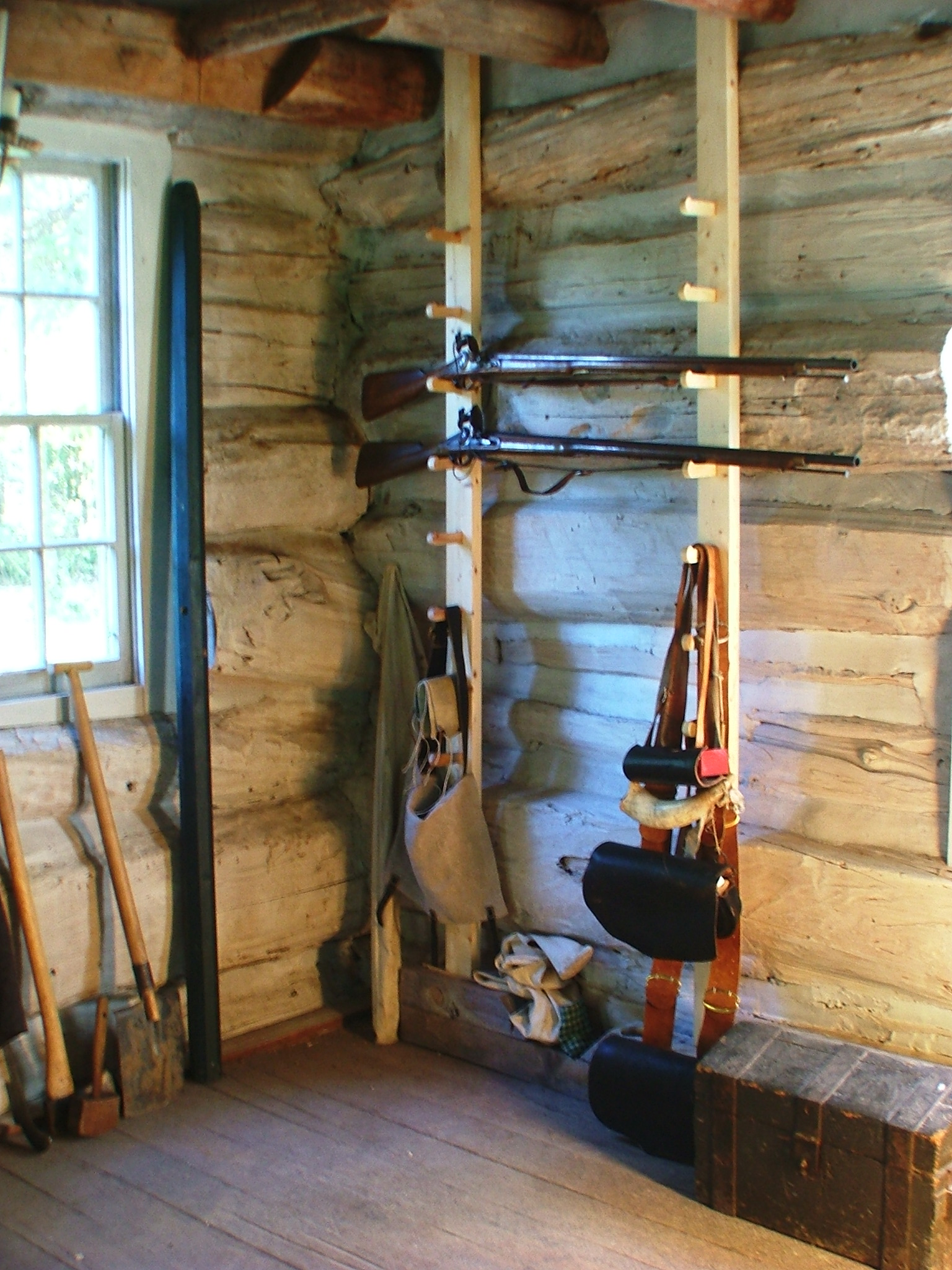
Portable Arms Rack, built for the 55th Regt, Compy of Light Infantry while being cantoned in a cabin, barrack, guard house, or other building. (Arms rack built by Robert Seidemann, member of the said unit.)
Source: Author’s photo.
As can be seen from the various figures, as well as primary source statements, there are a lot of options for lodging your arms at events. While I will not say “do not stack your arms, it is not documented for our time period,” you may find it prudent to utilized some of these suggestions.
Endnotes.
[1] Bouquet, Henry. The Papers of Henry Bouquet Vol. II.
[2] Lochee, Lewis. An Essay on Castramentation. Reprinted by The King’s Arms Press & Bindery.
[3] Bouquet. Page 678. “Bouquet Orderly Book, June 17 –
[4] Redmon, Barton. Email correspondence cited from A Soldiers Journal.
[5] Bouquet, Henry. Page 659. “Bouquet Orderly Book, June 17 –
[6] General Orders of 1757: issued by The Earl of Loudoun and Phineas Lyman in the Campaign Against the French. Gilliss Press,
[7] Sullivan, James (ed.) Sir William Johnson Papers Vol. III. The University of the State of
[8] Ibid., Page 85. “Prideaux and Johnson Orderly Book”, entry for
[9] Ibid., Page 69. “Prideaux and Johnson Orderly Book”, entry for
[10] LaCointe. The Science of Military Posts. Translated from French by an Officer. 1761. The King’s Arms Press & Bindery, Oldwick,
[11] Ibid., Page 95.
[12] Ibid., Page 94-95.
[13] Hawks, John. Orderly Book and Journal of Major John Hawks, 1759-1760. Page 45. Entry for
[14] O’Callaghan, EB. (ed.). Commissary Wison’s Orderly Book: Expedition of the British and Provincial Army, under Maj. Gen. Jeffrey Amherst, Against Ticonderoga and Crown Point, 1759. J. Munsell, Albany,
[15] LaCointe. Page 96.